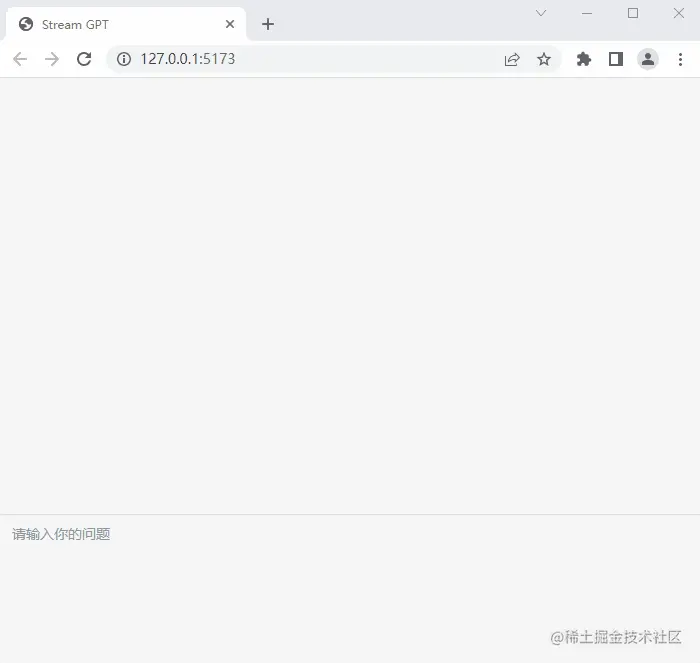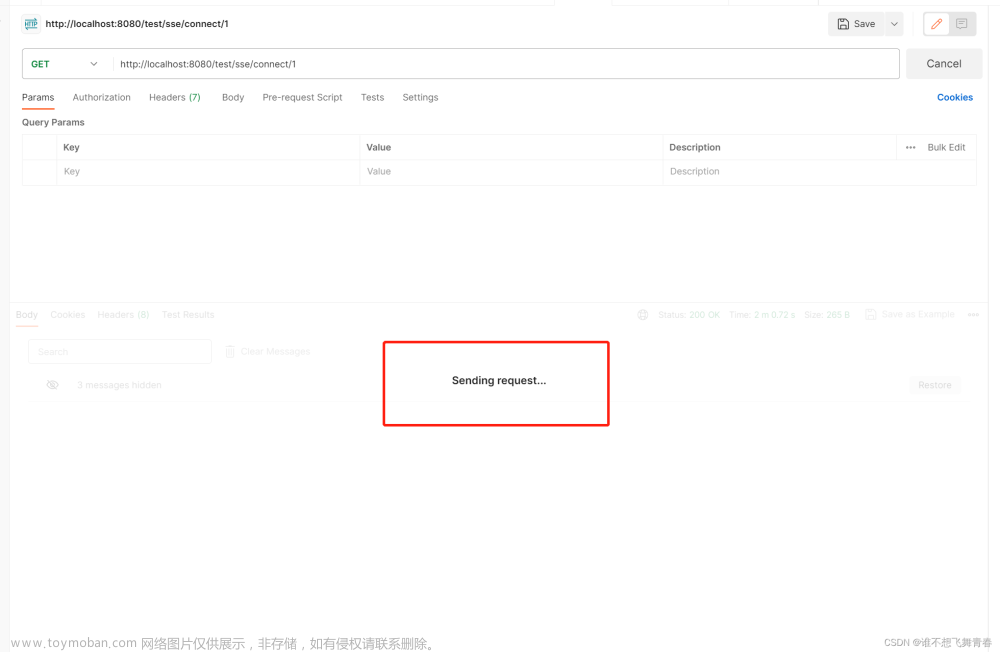在现代 Web 应用程序中,实时数据推送给前端变得越来越重要。无论是实时聊天、实时通知还是仪表板上的实时更新,都需要一种有效的方式来将数据推送给前端。本文将介绍两种常用的实现方法:WebSocket 和 Server-Sent Events(SSE),并提供详细的实现步骤。
二者对比
WebSocket 和 Server-Sent Events (SSE) 都是用于实现实时数据推送的技术,但它们在设计、用途和实现上有一些重要的区别。让我们详细比较这两种技术。
WebSocket:
-
双向通信:
- WebSocket 允许双向通信,客户端和服务器都可以在任何时候向对方发送数据。
- 这使得 WebSocket 非常适用于需要双向交互的应用,如在线聊天、多人协作工具等。
-
持久连接:
- WebSocket 建立持久连接,客户端和服务器之间的连接保持打开状态。
- 这减少了与建立和关闭连接相关的开销,适用于频繁的数据交换。
-
低延迟:
- 由于持久连接,WebSocket 可以实现低延迟的实时数据传输,适用于需要快速响应的应用。
-
复杂性:
- 实现 WebSocket 可能相对复杂,需要更多的服务器资源和额外的协议处理。
-
跨域通信:
- WebSocket 通常需要配置服务器以允许跨域通信,因为它们使用自定义协议。
-
浏览器支持:
- WebSocket 在现代浏览器中得到广泛支持。
Server-Sent Events (SSE):
-
单向通信:
- SSE 是一种单向通信,只允许服务器向客户端发送数据。客户端无法向服务器发送数据。
-
HTTP 协议:
- SSE 建立在 HTTP 协议之上,使用标准 HTTP 请求和响应。
- 这使得 SSE 更容易部署,因为它与现有的 HTTP 基础设施兼容。
-
简单性:
- SSE 的实现相对简单,服务器和客户端都不需要太多复杂的逻辑。
-
无需专用库:
- SSE 不需要额外的库或协议处理,客户端可以使用浏览器的原生 EventSource API 来接收数据。
-
跨域通信:
- SSE 支持跨域通信,可以通过 CORS(跨域资源共享)机制进行配置。
-
浏览器支持:
- SSE 在现代浏览器中也得到广泛支持,但与 WebSocket 相比,它的历史要长一些。
选择 WebSocket 还是 SSE:
-
WebSocket 适用于需要双向通信和低延迟的场景,例如在线游戏、实时聊天应用等。
-
SSE 适用于单向服务器到客户端的实时数据推送,例如新闻更新、实时股票报价、天气预报等,特别是当你希望使用现有的 HTTP 基础设施时。
-
在某些情况下,你甚至可以同时使用 WebSocket 和 SSE,根据不同的需求选择合适的技术。
无论选择哪种技术,都需要考虑你的应用程序的具体需求和复杂性。WebSocket 提供了更多的灵活性和功能,而 SSE 更加简单和易于部署。最终的选择取决于你的项目目标和资源。
Websocket 实现
使用原生 WebSocket API:
-
简单性:
- Spring Boot 提供了对原生 WebSocket API 的支持,使得创建 WebSocket 应用相对简单。
- 开发人员可以直接使用 Java 标准库中的 WebSocket 相关类来处理 WebSocket 通信。
-
依赖:
- 原生 WebSocket 不需要额外的依赖,因为 WebSocket API 已经包含在 Java 标准库中。
-
性能:
- 原生 WebSocket API 在性能方面表现良好,适用于大多数中小型应用。
-
生态系统:
- 使用原生 WebSocket 可以更容易地集成到现有的 Spring Boot 生态系统中,例如 Spring Security 等。
-
简单应用:
- 当你需要创建相对简单的 WebSocket 应用时,原生 WebSocket 是一个不错的选择。
使用 Netty 创建 WebSocket:
-
灵活性:
- Netty 是一个高度可定制的异步事件驱动框架,它可以用于创建各种网络应用,包括 WebSocket。
- Netty 提供了更多的灵活性和自定义选项,适用于复杂的 WebSocket 应用。
-
性能:
- Netty 以其高性能和低延迟而闻名,适用于需要处理大量并发连接的应用。
-
协议支持:
- Netty 支持多种协议,不仅限于 WebSocket。这意味着你可以在同一个应用程序中处理多种网络通信需求。
-
集成:
- 尽管 Netty 可以集成到 Spring Boot 中,但其集成可能需要更多的配置和代码。
-
复杂应用:
- 当你需要处理复杂的 WebSocket 场景,如高并发、自定义协议、复杂的消息处理等时,使用 Netty 是更好的选择。
总结和选择:
选择原生 WebSocket 还是使用 Netty 创建 WebSocket 应取决于你的项目需求和复杂性:
-
如果你的应用相对简单,对性能要求不是很高,可以考虑使用原生 WebSocket API,它更容易上手并且不需要额外的依赖。
-
如果你的应用需要处理高并发、复杂的协议、自定义消息处理或需要最大程度的性能和灵活性,那么使用 Netty 创建 WebSocket 可能更合适。Netty 为你提供了更多的控制权和自定义选项。
无论你选择哪种方法,Spring Boot 都提供了良好的支持,使得在应用中集成 WebSocket 变得相对容易。因此,你可以根据具体的项目需求来选择适合你的方法。
Netty 实现 Websocket
-
添加 maven 坐标
<!-- netty --> <dependency> <groupId>io.netty</groupId> <artifactId>netty-common</artifactId> <version>4.1.79.Final</version> </dependency> -
创建 NettyWebsocketServer
package com.todoitbo.baseSpringbootDasmart.netty.server; import com.todoitbo.baseSpringbootDasmart.netty.handler.HeartbeatHandler; import com.todoitbo.baseSpringbootDasmart.netty.handler.WebSocketHandler; import io.netty.bootstrap.ServerBootstrap; import io.netty.channel.*; import io.netty.channel.nio.NioEventLoopGroup; import io.netty.channel.socket.SocketChannel; import io.netty.channel.socket.nio.NioServerSocketChannel; import io.netty.handler.codec.http.HttpObjectAggregator; import io.netty.handler.codec.http.HttpServerCodec; import io.netty.handler.codec.http.websocketx.WebSocketServerProtocolHandler; import io.netty.handler.stream.ChunkedWriteHandler; import io.netty.handler.timeout.IdleStateHandler; import io.netty.handler.traffic.ChannelTrafficShapingHandler; /** * @author xiaobo * @date 2023/9/5 */ public class NettyWebsocketServer { private final int port; public NettyWebsocketServer(int port) { this.port = port; } public void run() throws Exception { EventLoopGroup bossGroup = new NioEventLoopGroup(1); // 创建用于接受客户端连接的 boss 线程池 EventLoopGroup workerGroup = new NioEventLoopGroup(); // 创建用于处理客户端请求的 worker 线程池 try { ServerBootstrap b = new ServerBootstrap(); b.group(bossGroup, workerGroup) .channel(NioServerSocketChannel.class) .childHandler(new ChannelInitializer<SocketChannel>() { @Override public void initChannel(SocketChannel ch) throws Exception { ChannelTrafficShapingHandler trafficShapingHandler = new ChannelTrafficShapingHandler( 1, // 读取速率限制(字节/秒) 1, // 写入速率限制(字节/秒) 1, // 流量检查时间间隔(毫秒) 1 // 最大允许的时间窗口(毫秒) ); ChannelPipeline pipeline = ch.pipeline(); // 添加心跳检测处理器,3秒内没有读写事件将触发 IdleStateEvent,下面的顺序错了也会出现问题的 pipeline.addLast(new IdleStateHandler(30, 0, 0)); pipeline.addLast(new HeartbeatHandler()); pipeline.addLast(new HttpServerCodec()); // 处理 HTTP 请求 pipeline.addLast(new ChunkedWriteHandler()); // 写大数据流的处理器 pipeline.addLast(new HttpObjectAggregator(8192)); // 将 HTTP 消息聚合为 FullHttpRequest 或 FullHttpResponse // pipeline.addLast(new WebSocketFrameAggregator(8192)); // 将 HTTP 消息聚合为 FullHttpRequest 或 FullHttpResponse // pipeline.addLast(new WebSocketServerCompressionHandler()); // 消息压缩 pipeline.addLast(new WebSocketHandler()); // 自定义 WebSocket 处理器 pipeline.addLast(new WebSocketServerProtocolHandler("/ws", null, true, 65536 * 10)); // 处理 WebSocket 升级握手和数据帧处理 } }) .option(ChannelOption.SO_BACKLOG, 128) // 设置服务器接受队列大小 .childOption(ChannelOption.SO_KEEPALIVE, true); // 开启 TCP 连接的 Keep-Alive 功能 // Bind and start to accept incoming connections. System.out.println("TCP server started successfully"); ChannelFuture f = b.bind(port).sync(); // 绑定端口并等待绑定完成 // Wait until the server socket is closed. // In this example, this does not happen, but you can do that to gracefully // shut down your server. f.channel().closeFuture().sync(); // 阻塞直到服务器关闭 } finally { // 优雅地关闭线程池 workerGroup.shutdownGracefully(); bossGroup.shutdownGracefully(); } } }
这里需要注意一下,
pipeline.addLast的顺序不一致可能会导致程序报错,运行时
-
创建心跳 handle
package com.todoitbo.baseSpringbootDasmart.netty.handler; import io.netty.channel.ChannelHandlerContext; import io.netty.channel.ChannelInboundHandlerAdapter; import io.netty.handler.timeout.IdleState; import io.netty.handler.timeout.IdleStateEvent; public class HeartbeatHandler extends ChannelInboundHandlerAdapter { int readTimeOut = 0; @Override public void userEventTriggered(ChannelHandlerContext ctx, Object evt) throws Exception { IdleStateEvent event = (IdleStateEvent) evt; if(event.state() == IdleState.READER_IDLE){ readTimeOut++; } if(readTimeOut >= 3){ System.out.println("超时超过3次,断开连接"); ctx.close(); } } } -
创建WebSocketHandler
package com.todoitbo.baseSpringbootDasmart.netty.handler; import cn.hutool.core.collection.CollectionUtil; import com.todoitbo.baseSpringbootDasmart.netty.NamedChannelGroup; import io.netty.buffer.ByteBuf; import io.netty.buffer.Unpooled; import io.netty.channel.*; import io.netty.handler.codec.http.*; import io.netty.handler.codec.http.websocketx.*; import io.netty.util.AttributeKey; import io.netty.util.CharsetUtil; import lombok.extern.slf4j.Slf4j; import java.util.HashMap; import java.util.List; import java.util.Map; /** * @author xiaobo */ @Slf4j public class WebSocketHandler extends SimpleChannelInboundHandler<Object> { private WebSocketServerHandshaker handshaker; public static final AttributeKey<String> USER_ID_KEY = AttributeKey.valueOf("userId"); public static final AttributeKey<String> GROUP_ID_KEY = AttributeKey.valueOf("groupId"); private static final Map<Channel, String> WORK_CHANNEL_MAP = new HashMap<Channel,String>(); @Override public void channelActive(ChannelHandlerContext ctx) throws Exception { log.info("与客户端建立连接,通道开启!"); // 添加到channelGroup通道组(广播) // 之后可以根据ip来进行分组 NamedChannelGroup.getChannelGroup("default").add(ctx.channel()); } @Override public void channelInactive(ChannelHandlerContext ctx) throws Exception { log.info("与客户端断开连接,通道关闭!"); // 从channelGroup通道组(广播)中删除 // 之后可以根据ip来进行分组 Channel channel = ctx.channel(); NamedChannelGroup.getChannelGroup("default").remove(channel); WORK_CHANNEL_MAP.remove(channel); } public boolean userAuthentication(ChannelHandlerContext ctx,FullHttpRequest req) { // 提取URI参数 QueryStringDecoder queryStringDecoder = new QueryStringDecoder(req.uri()); Map<String, List<String>> parameters = queryStringDecoder.parameters(); // 根据参数进行处理 List<String> userId = parameters.get("userId"); List<String> groupId = parameters.get("groupId"); if (CollectionUtil.isNotEmpty(userId) && CollectionUtil.isNotEmpty(groupId)) { ctx.channel().attr(USER_ID_KEY).set(userId.get(0)); ctx.channel().attr(GROUP_ID_KEY).set(groupId.get(0)); return true; }else { return false; } } private void handleHttpRequest(ChannelHandlerContext ctx, FullHttpRequest req) { // 检查是否升级到WebSocket if (!req.decoderResult().isSuccess() || (!"websocket".equals(req.headers().get("Upgrade")))) { // 如果不是WebSocket协议的握手请求,返回400 Bad Request响应 sendHttpResponse(ctx, req, new DefaultFullHttpResponse(HttpVersion.HTTP_1_1, HttpResponseStatus.BAD_REQUEST)); return; } // 构建握手响应 WebSocketServerHandshakerFactory wsFactory = new WebSocketServerHandshakerFactory( getWebSocketLocation(req), null, true); handshaker = wsFactory.newHandshaker(req); if (handshaker == null) { // 如果不支持WebSocket版本,返回HTTP 426 Upgrade Required响应 WebSocketServerHandshakerFactory.sendUnsupportedVersionResponse(ctx.channel()); } else { handshaker.handshake(ctx.channel(), req); // 进行WebSocket握手 // 在认证成功后,设置用户ID到Channel属性中 boolean authentication = userAuthentication(ctx,req);// 这里需要实现用户认证逻辑 if (!authentication) { // 用户认证失败,可能需要关闭连接或发送认证失败消息 // 1. 关闭连接: ctx.close(); // 2. 发送认证失败消息给客户端: String failureMessage = "认证失败,请提供有效的身份验证信息。"; ctx.writeAndFlush(failureMessage); return; } // 其他逻辑... WORK_CHANNEL_MAP.put(ctx.channel(), ctx.channel().attr(GROUP_ID_KEY).get()); } } private void sendHttpResponse(ChannelHandlerContext ctx, FullHttpRequest req, FullHttpResponse res) { // 发送HTTP响应 if (res.status().code() != 200) { ByteBuf buf = Unpooled.copiedBuffer(res.status().toString(), CharsetUtil.UTF_8); res.content().writeBytes(buf); buf.release(); HttpUtil.setContentLength(res, res.content().readableBytes()); } ChannelFuture future = ctx.channel().writeAndFlush(res); if (!HttpUtil.isKeepAlive(req) || res.status().code() != 200) { future.addListener(ChannelFutureListener.CLOSE); } } private String getWebSocketLocation(FullHttpRequest req) { return "ws://" + req.headers().get(HttpHeaderNames.HOST) + req.uri(); } private void handleWebSocketFrame(ChannelHandlerContext ctx, WebSocketFrame frame) { // 处理WebSocket消息,可以根据实际需求进行处理 if (frame instanceof TextWebSocketFrame) { // 处理文本消息 String text = ((TextWebSocketFrame) frame).text(); System.out.println("Received message: " + text); // 可以在这里处理WebSocket消息并发送响应 // ... } else if (frame instanceof BinaryWebSocketFrame) { // 处理二进制WebSocket消息 // ... System.out.println("123"); } else if (frame instanceof CloseWebSocketFrame) { // 处理WebSocket关闭请求 handshaker.close(ctx.channel(), (CloseWebSocketFrame) frame.retain()); } else if (frame instanceof PingWebSocketFrame) { // 处理WebSocket Ping消息 System.out.println("cs"); ctx.channel().write(new PongWebSocketFrame(frame.content().retain())); } } @Override protected void channelRead0(ChannelHandlerContext ctx, Object msg) throws Exception { if (msg instanceof FullHttpRequest) { // 处理HTTP握手请求 handleHttpRequest(ctx, (FullHttpRequest) msg); } else if (msg instanceof WebSocketFrame) { // 处理WebSocket消息 handleWebSocketFrame(ctx, (WebSocketFrame) msg); } } @Override public void exceptionCaught(ChannelHandlerContext ctx, Throwable cause) { // 发生异常时的处理 log.error(cause.getMessage()); ctx.close(); } } -
创建NamedChannelGroup
package com.todoitbo.baseSpringbootDasmart.netty; import io.netty.channel.group.ChannelGroup; import io.netty.channel.group.DefaultChannelGroup; import io.netty.util.concurrent.GlobalEventExecutor; import java.util.Map; import java.util.concurrent.ConcurrentHashMap; public class NamedChannelGroup{ private String groupName; public static Map<String,ChannelGroup> channelGroupMap = new ConcurrentHashMap<>(); static { channelGroupMap.put("default", new DefaultChannelGroup(GlobalEventExecutor.INSTANCE)); } public static void setGroupName(String groupName){ channelGroupMap.put(groupName, new DefaultChannelGroup(GlobalEventExecutor.INSTANCE)); } public static ChannelGroup getChannelGroup(String groupName){ return channelGroupMap.get(groupName); } }
Server-Sent Events (SSE)实现
创建DataManager
package com.todoitbo.baseSpringbootDasmart.sse;
import org.springframework.http.MediaType;
import org.springframework.stereotype.Component;
import org.springframework.web.servlet.mvc.method.annotation.SseEmitter;
import java.io.IOException;
import java.util.ArrayList;
import java.util.HashMap;
import java.util.List;
import java.util.Map;
/**
* 数据管理器用于管理Server-Sent Events (SSE) 的订阅和数据推送。
* @author xiaobo
*/
@Component
public class DataManager {
private final Map<String, List<SseEmitter>> dataEmitters = new HashMap<>();
/**
* 订阅特定数据类型的SSE连接。
*
* @param dataType 要订阅的数据类型
* @param emitter SSE连接
*/
public void subscribe(String dataType, SseEmitter emitter) {
dataEmitters.computeIfAbsent(dataType, k -> new ArrayList<>()).add(emitter);
emitter.onCompletion(() -> removeEmitter(dataType, emitter));
emitter.onTimeout(() -> removeEmitter(dataType, emitter));
}
/**
* 推送特定数据类型的数据给所有已订阅的连接。
*
* @param dataType 要推送的数据类型
* @param data 要推送的数据
*/
public void pushData(String dataType, String data) {
List<SseEmitter> emitters = dataEmitters.getOrDefault(dataType, new ArrayList<>());
emitters.forEach(emitter -> {
try {
emitter.send(SseEmitter.event().data(data, MediaType.TEXT_PLAIN));
} catch (IOException e) {
removeEmitter(dataType, emitter);
}
});
}
private void removeEmitter(String dataType, SseEmitter emitter) {
List<SseEmitter> emitters = dataEmitters.get(dataType);
if (emitters != null) {
emitters.remove(emitter);
}
}
}
接口实现
package com.todoitbo.baseSpringbootDasmart.controller;
import com.todoitbo.baseSpringbootDasmart.sse.DataManager;
import org.springframework.http.MediaType;
import org.springframework.http.ResponseEntity;
import org.springframework.web.bind.annotation.GetMapping;
import org.springframework.web.bind.annotation.PathVariable;
import org.springframework.web.bind.annotation.RequestMapping;
import org.springframework.web.bind.annotation.RestController;
import org.springframework.web.servlet.mvc.method.annotation.SseEmitter;
import javax.annotation.Resource;
/**
* @author xiaobo
*/
@RestController
@RequestMapping("/environment")
public class EnvironmentController {
@Resource private DataManager dataManager;
@GetMapping(value = "/subscribe", produces = MediaType.TEXT_EVENT_STREAM_VALUE)
public SseEmitter subscribe() {
SseEmitter emitter = new SseEmitter();
dataManager.subscribe("environment", emitter);
return emitter;
}
// 示例:推送环境监测数据给前端
@GetMapping("/push/{testText}")
public ResponseEntity<String> pushEnvironmentData(@PathVariable String testText) {
dataManager.pushData("environment", testText);
return ResponseEntity.ok("Data pushed successfully.");
}
}
实现说明
每个不同类型的数据推送都需要一个对应的SSE订阅端点(subscribe)。每个数据类型都有一个对应的订阅端点,用于前端建立SSE连接,并在后端接收和处理特定类型的数据推送。
在你的后端应用中,对于每种数据类型,你需要创建一个对应的Controller或处理器来处理该数据类型的SSE订阅。每个Controller会有自己的SSE订阅端点,前端可以连接到不同的端点以接收相应类型的数据。
这种方式允许你将不同类型的数据推送逻辑分离,使代码更具可维护性和可扩展性。当有新的数据可用时,只需调用相应类型的数据推送方法,而不必修改通用的SSE管理逻辑。
前端实现
<!DOCTYPE html>
<html>
<head>
<title>SSE Data Receiver</title>
</head>
<body>
<h1>Real-time Data Display</h1>
<div id="data-container"></div>
<script>
const dataContainer = document.getElementById('data-container');
// 创建一个 EventSource 对象,指定 SSE 服务器端点的 URL
const eventSource = new EventSource('http://127.0.0.1:13024/environment/subscribe'); // 根据你的控制器端点来设置URL
// 添加事件处理程序,监听服务器端发送的事件
eventSource.onmessage = (event) => {
const data = event.data;
// 在这里处理从服务器接收到的数据
// 可以将数据显示在页面上或进行其他操作
const newDataElement = document.createElement('p');
newDataElement.textContent = data;
dataContainer.appendChild(newDataElement);
};
eventSource.onerror = (error) => {
// 处理连接错误
console.error('Error occurred:', error);
};
</script>
</body>
</html>
弊端以及解决方案
如果你没什么处理的话,在它首次调用subscribe时候可能会出现连接超时的问题,因为这个是一个长连接,出现这种问题是因为,此时并没有数据产生,至此,除非你刷新页面,否则即使有数据产生前端也不会受到了
你希望前端在第一次订阅SSE连接后,即使后端没有数据产生,之后也能接收到数据。这可以通过以下方式来实现:
-
保持持久连接: 确保前端建立的SSE连接是持久性连接,不会在第一次连接成功后关闭。这可以让连接一直保持打开状态,即使后端没有即时数据产生。你可以在前端代码中使用以下方式来确保连接持久:
const eventSource = new EventSource('/environment/subscribe');默认情况下,EventSource对象会自动重连,以保持连接的持久性。
-
定期发送心跳数据: 在后端定期发送一些心跳数据,以确保连接保持活跃。这可以防止连接超时关闭。你可以在后端定期发送一个包含无用信息的SSE事件,例如:
@Scheduled(fixedRate = 30000) // 每30秒发送一次心跳数据 public void sendHeartbeat() { dataManager.pushData("heartbeat", "Heartbeat data"); }前端可以忽略这些心跳事件,但它们会保持连接处于活跃状态。
-
前端自动重连: 在前端代码中添加自动重连逻辑,以处理连接断开的情况。这样,如果连接由于某种原因断开,前端会自动尝试重新建立连接。示例:文章来源:https://www.toymoban.com/news/detail-754505.html
const eventSource = new EventSource('/environment/subscribe'); eventSource.onerror = (error) => { // 处理连接错误 console.error('Error occurred:', error); // 重新建立连接 eventSource.close(); setTimeout(() => { // 重新建立连接 eventSource = new EventSource('/environment/subscribe'); }, 1000); // 1秒后重试 };
通过结合上述方法,你可以确保前端能够建立并保持持久SSE连接,即使后端没有即时数据产生。这样,一旦后端有数据产生,前端也可以接收到数据而无需重新订阅。文章来源地址https://www.toymoban.com/news/detail-754505.html
到了这里,关于WebSocket vs SSE: 实时数据推送到前端的选择与实现(详细)的文章就介绍完了。如果您还想了解更多内容,请在右上角搜索TOY模板网以前的文章或继续浏览下面的相关文章,希望大家以后多多支持TOY模板网!



![ChatGPT 前端流式数据如何处理?本文提供三种方案为你揭开疑惑【websocket、SSE、fetch Stream]](https://imgs.yssmx.com/Uploads/2024/02/765741-1.png)





